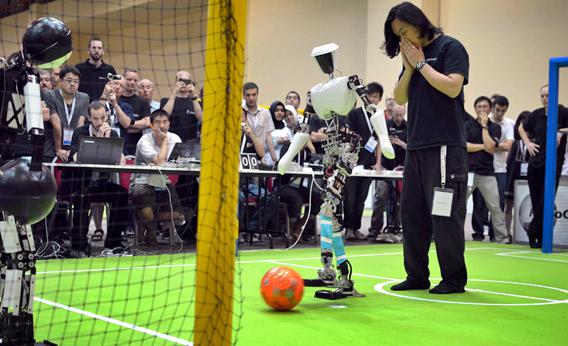This month, soccer fans are glued to Euro 2012. But another prestigious championship is about to kick off, too. The game is slower—much slower—and the players fall down a lot, but they’re still the best of the best in their corner of the soccer world. And for robots, they’re pretty adorable.
RoboCup, the annual robot soccer championships, begins next week in Mexico City. Roboticists from around the world will show off their sporty creations in five categories, including humanoid and standard platform, in which everyone uses the same basic machine (an Alderbaran Nao) but programs it with their own software. The mission: to have a winning RoboCup team play human World Cup victors in a competitive game by 2050. The RoboCup’s organizers admit that at current rates of technological progress, professional soccer players won’t have to worry about unemployment by robot takeover any time soon. But still: It’s robot soccer! The gameplay itself might not be exciting (“It takes two minutes to kick a single goal,” one participant told me), but the concept is pretty cool.
So, what’s the point—why are some of the world’s most creative roboticists wasting making machines that don’t play as well as a talented 4-year-old? Because soccer-playing robots are a great stepping stone for more practical innovations. Since the first official RoboCup was held in 1997, machines built for the tournament have generated dramatic breakthroughs, leading to robots that may one day take up arms on the battlefield, rescue people from disaster areas, fight fires, and work in our homes.
To see how these athletically inclined electronic concoctions are changing the robot world, I visited Virginia Tech, whose Team RoMeLa dominated the 2011 RoboCup, winning both the adult- and kid-size divisions. (For the latter competition, Virginia Tech partners with the University of Pennsylvania.) The morning is not best the time to visit a robot soccer team: The night before my visit, many of the roboticists, including professor Dennis Hong, who heads the group, had been working until 2 or 3 a.m., making the early part of the day relative quiet. A trio of students fiddled with a short robo-athlete on a regulation robot soccer field. By league rules, the bots’ battleground is a small carpet of green with yellow-and-blue goals and white lines. The ball must be orange. Variation from these colors may confuse the robot—team captains, who sometimes have to step into the field during play, must wear dark colors so they’re not mistaken for goal posts.
For budding engineers, RoboCup is something of a gateway drug. “[I]t is a great point to get students started with robotics, and most of them stay to work on other robotic projects afterward,” says Dorian Scholz, the team captain of the German-based Darmstadt Dribblers. When it comes to research and development, the soccer field serves as a sort of incubation space. “Most of the tech built for the RoboCup is the tech we need to use” in other contexts, says Hong. Vision, autonomy, balance, the ability to coordinate actions, stable locomotion—all of these are important on the soccer field and outside the robo-athletic sphere, particularly when it comes to using robots for dangerous tasks.
Take the Shipboard Autonomous Firefighting Robot, which Virginia Tech and Penn are working on together. SAFFiR, which made tech headlines in March, is being designed to put out fires on Navy ships. On a basic level, it is based on one of Virginia Tech’s most successful RoboCup bots, CHARLI-2. Their experience with CHARLI didn’t just bolster Virginia Tech and Penn’s credibility. It also helped them learn about power requirements, weight distribution, and other details that will make SAFFiR work for the Navy’s purposes.
RoboCup has led to advances in commerce as well. Manuela Veloso of Carnegie Mellon University, who helped conceive of the robo-soccer competition in the 1990s, points to Kiva Systems, the robotics company acquired earlier this year by Amazon. Kiva robots staff distribution centers, allowing for efficient work around the clock. Several years ago, Kiva co-founder Mick Mountz was watching videos of RoboCup and decided to reach out to Raffaello D’Andrea, an ex-member of Cornell’s RoboCup team. D’Andrea came onboard at Kiva in 2003, bringing his RoboCup experience with him. “A lot of the techniques that are used for planning the paths of these robots, avoiding obstacles, going around each other, all of them coordinated … it’s very related to RoboCup,” says Veloso.
Germany’s Darmstadt Dribblers also took communication technology developed for RoboCup as a starting point for a search-and-rescue robot. There is a great deal of overlap between robot soccer and rescue bots—just as all the players on a sports team need to coordinate, so do machines that sift through rubble. On account of those similarities, RoboCup hosts a parallel competition, the RoboCup Rescue Robot League. The contest’s 2012 scenario: “to find victims, determine their situation, state, and location, and then report back their findings in a map of the building with associated victim data.”
After the RoboCup, Team RoMeLa will get to work on the DARPA Robotics Challenge, which is seeking machines for disaster assistance. The DARPA Challenge may require robots to, among other things, drive a vehicle, climb a ladder, and use a tool to break concrete. This is incredibly similar to the requirements of the RoboCup Rescue Robot League. That gives the Virginia Tech team—and all of the other robot builders—a huge head start on a problem that could benefit us all.
Robot Soccer: A Hilarious and Terrifying Vision of Our Sporting Future
This article arises from Future Tense, a collaboration among Arizona State University, the New America Foundation, and Slate. Future Tense explores the ways emerging technologies affect society, policy, and culture. To read more, visit the Future Tense blog and the Future Tense home page. You can also follow us on Twitter.
